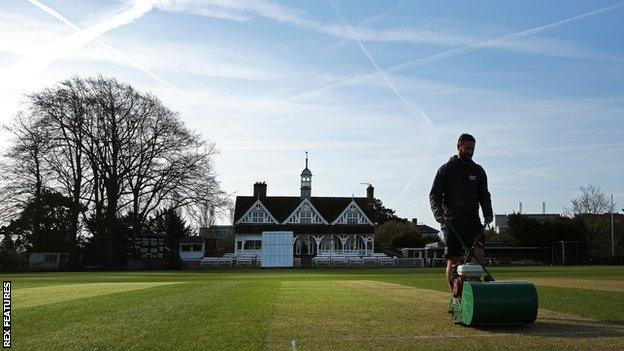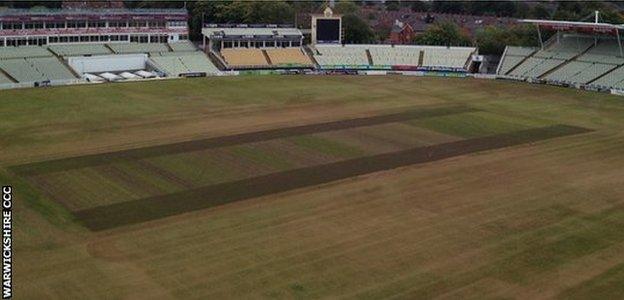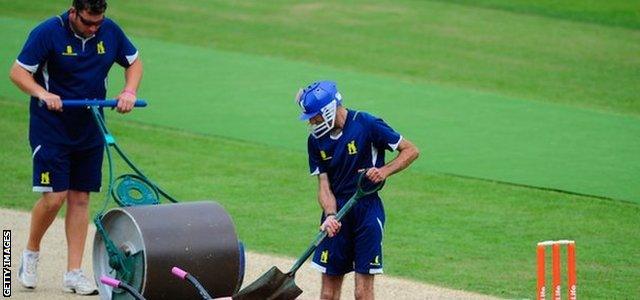County Championship: How do you prepare a cricket pitch?
- Published

The new County Championship season gets under way this Sunday
When the first ball of the County Championship season is bowled this Sunday, fans and players alike will look admiringly on the verdant carpet-like playing surfaces.
Most of them are unaware that it takes from the day after the final action of last season and all through winter to get ready for this weekend.
But what actually happens to get a cricket pitch ready? BBC Sport spoke to head groundsmen at Warwickshire's Edgbaston, an international Test cricket ground, and Worcestershire's New Road.
Post-season preparations
Gary Barwell, head groundsman at Warwickshire County Cricket Club, is in charge of getting the Edgbaston pitch ready to play at least 20 Warwickshire matches in all formats, T20 Finals Day as well as England's one-day international against Sri Lanka and the third Test against Pakistan.
"The day after the last day of play in September, a tractor with a scarifier - which is a heavy duty tool with tines - goes into the cricket square," Barwell told BBC Sport.
"We dig it up to a degree and do it in different directions, from 1mm to 10mm deep. This is done to get a nice even level, get rid of organic matter and establish a seed bed.
"When that finishes, it's cut to about 2mm in length so the only thing you see is soil and small white fibres of grass. We aim to get the profile clean, so the soil is genuine soil, and then get a lovely grass coverage over it."
Once the scarifying is finished, the square is brushed before it is completely flooded prior to reseeding and top-dressing, which is when the square starts to develop its distinctive earthy characteristic.

This picture, taken in autumn 2012, shows the surface at Edgbaston after the immediate post-season work is completed
"When seeding, the tractor goes in three or four different directions but the last place we go is in the direction of play because otherwise you will always see an angle," explained Barwell. "Then we top up the ends of the square with top-dressing to level them out as that's where the bowlers bowl from.
"By 2 October last year we were finished, top dressed, fertilised and the square was put to bed for winter within five days of starting."
When the grass has germinated, a process which takes between seven and 14 days, it is monitored, drained and cut over winter until the beginning of the season.
"At the end of November we were ready for verti-draining, which is deep spiking. We went down to nine inches this year. That means the water and air movement can get down there, meaning the pitches hold together better."
Entering 'flood mode'
Worcestershire's New Road presents a unique problem to the club's head groundsman, Tim Packwood. The ground is on the floodplain of the nearby River Severn and floods most winters.
"We try to get the work done quickly because we have been underwater from the flooding in October before," he said. "The earlier we can get the seed in, the stronger the grasses will be before they go underwater."
Once Packwood and his ground staff have finished preparing the cricket square, the ground is put in to "flood mode", where everything is taken offsite and machinery is sent for service, apart from two rotary mowers.
This winter, water entered New Road on New Year's Eve and completely engulfed the ground by 2 January. The flooding finally left the site on 19 January - but there was more misery to come when the ground flooded again just weeks later.

Worcestershire's New Road ground floods most winters, as it is situated on the floodplain of the River Severn
"The first flood didn't leave a great deal of damage on the square so we stayed off for about two weeks," said Packwood. "We had a week of good drying weather and then we were able to get out there. All of the outfield was cut, verti-drained and fertilised in the first week of February.
"Over the weekend we had some torrential rain again and, from Saturday night to Sunday, the river came up 2.2m in 13 hours. By 9 February we were underwater again.
"With every flood you get a bit disheartened but that one was very disheartening because everything was done. The water didn't leave until 17 February."
Clearing the way
Worcestershire begin their County Championship season against Kent on 10 April but it has taken a lot of work to get the pitch in a playable state after the second flood.
"With technology now, you've normally got three or four days' notice that it will flood," continued Packwood. "We put a couple of markers at the top and bottom ends of the square. Once the flood water starts to go and you can start to see the posts, we know it's nearing time we can go out there.
"We take a chain mat out and drag that backwards and forwards across the square as the water goes down. You pull it backwards and forwards and it works the silt into the holes. If you can disturb the silt, some will settle but the majority won't settle on the square.
"We don't walk on the square itself because we'll damage it. From the markers, we know how far the mat has got to come. It is put in about four foot from the square. When you're in line with that you know how far you can go without damaging it."
With the ground situated next to the river and fields, a solution to the flooding is unlikely, but Packwood does hope he can find a more efficient solution to clearing the water.
"We've looked into defences," he said. "People ask whether we could build a temporary wall but all the drains back up and the water suddenly comes back up. You can see it bubbling up underneath before the water actually gets on. I don't think there's anything you can really do.
"We're on the floodplain; the water will find its level no matter what you do. There's got to be an easier method of matting, even if it were to involve a flat-bottom boat or something."
'The best job in the world'

There are six groundstaff who work for Warwickshire County Cricket Club
Coming off the back of a big season at Edgbaston, which included England's victorious third Ashes Test against Australia and another T20 Finals Day, Warwickshire groundsman Barwell is proud of his efforts.
"It can be the best job in the world, such as last year with the Ashes. The plaudits the club and ground staff received was great," said Barwell.
"People like former England batsman Geoffrey Boycott said it was a fantastic Test pitch. That's as good as it gets - you don't need money for that. I'll take that with me for the rest of my life."
At New Road, despite the misery of two floods, Packwood still he finds the job rewarding.
"It's got harder and harder as the years have gone on," he said. "You would have thought with a bit more experience it would get easier. It just seems to be more testing each year, but we wouldn't do it if we didn't enjoy it."
- Published23 July 2015

- Published15 May 2018

- Published18 October 2019
